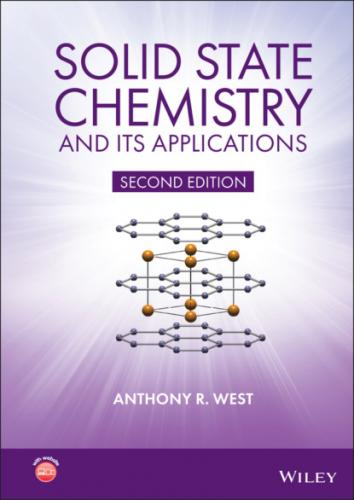2 Compounds of heavy p‐block atoms in their lower oxidation states (e.g. Tl+, Pb2+, Bi3+) often have distorted polyhedra in which the cation exhibits the inert pair effect, as with TlF, above. Thus, in PbO and SnO the M2+ ion has four O2– neighbours to one side giving a square pyramidal arrangement, Fig. 3.14. InBi is similar with Bi3+ showing the inert pair effect and irregular coordination.
1.17.6 Rutile (TiO2), cadmium iodide (CdI2), cadmium chloride (CdCl2) and caesium oxide (Cs2O)
The title structures, together with fluorite, represent the main AX2 structure types. The unit cell of rutile is tetragonal a = b = 4.594 Å, c = 2.958 Å, and is shown in Fig. 1.37(a). The Ti positions, two per cell, are fixed at the corner 0, 0, 0 and body centre
The body centre Ti at
Figure 1.37 The rutile structure, TiO2: (a) the unit cell; (b) TiO6 octahedra in two orientations in the unit cell; (c) an array of octahedra in 3D; (d) oxygen atoms in zig‐zag arrangement; (e) oxygen atoms in an ideal hcp structure in projection; (f) [001] projection of the structure showing fourfold screw axes and twofold rotation axes.
The TiO6 octahedra link by sharing edges and corners to form a 3D framework. Consider the TiO6 octahedron in the centre of the cell in Fig. 1.37(b); a similar octahedron in identical orientation occurs in the cells above and below such that octahedra in adjacent cells share edges to form infinite chains parallel to c. For example, Ti at
The rutile structure is also commonly described as a distorted hcp oxide array with half the octahedral sites occupied by Ti. A 3 × 3 block of unit cells is shown in Fig. 1.37(d) with only the oxygen positions marked. Corrugated cp layers occur, both horizontally and vertically. This contrasts with the undistorted hcp arrangement (e), in which the layers occur in one orientation only (horizontally).
The octahedral sites between two cp layers in an ideal hcp anion array are shown in the projection in Fig. 1.38(a). While all these sites are occupied in NiAs [Fig. 1.35(h)], only half are occupied in rutile and in such a manner that alternate horizontal rows of octahedral sites are full and empty. The orientation of the tetragonal unit cell in rutile is shown. Parallel to the tetragonal c axis, horizontally, the TiO6 octahedra share edges. This is shown in Fig. 1.38(b) for two octahedra with oxygens 1 and 2 forming the common edge.
An alternative, and more accurate, way to describe the packing arrangement of oxide ions in rutile is as a slightly distorted version of a different type of packing called tetragonal packing (tp), characterised by a sphere coordination number of 11 which contrasts with hcp and ccp which have a packing sphere coordination number of 12. The symmetry of tp is quite different to that of hcp since tp is characterised by fourfold rotational symmetry without any threefold symmetry whereas hcp has no fourfold symmetry but is characterised by threefold (or sixfold) symmetry. An [001] projection of the rutile structure is shown in Fig. 1.37(f); the fourfold symmetry shown is not a simple rotation axis but is a fourfold screw axis in which the structure rotates by 90° and translates by half the unit cell in the [001] direction.
The bond lengths in TiO2 may be calculated readily; for the Ti–O bond between Ti at
Figure 1.38 (a) Octahedral sites in an ideal hcp array; (b) edge‐sharing octahedra.
Table 1.15 Some compounds with the rutile structure
| Compound | a/Å | c/Å | x | Compound | a/Å | c/Å | x |
|---|---|---|---|---|---|---|---|
| TiO2 |
|
